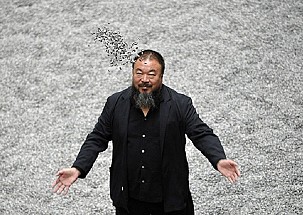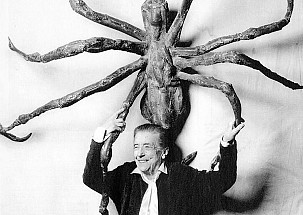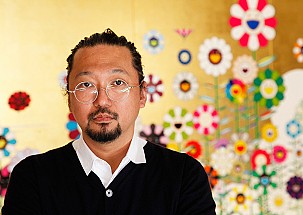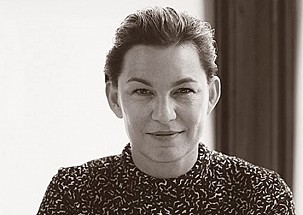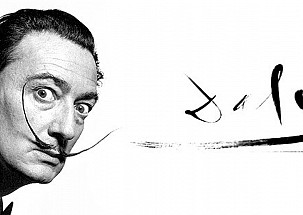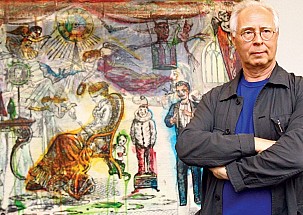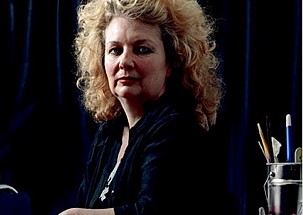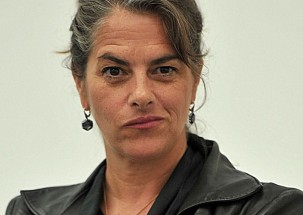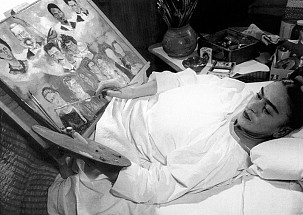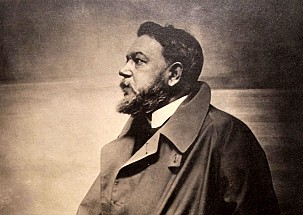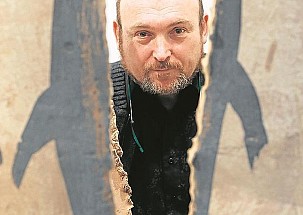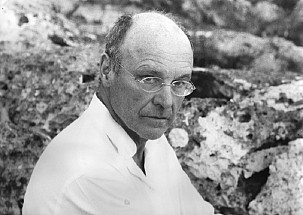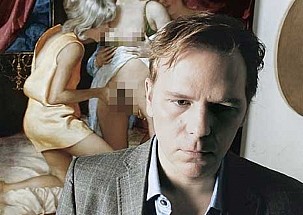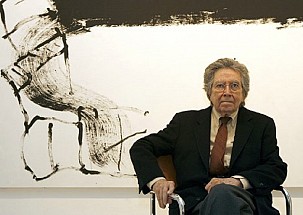This is the story of a 21st century Iranian woman and a 19th century Spanish man meeting together in the Prado Museum, Madrid. The East/West frontier and the 200 years that separate them dissolve through the use of imagery, a means of expression first used by Goya and then by Farideh Lashai so as to denounce the dramas surrounding them: fratricidal wars, the cruelty of and between men, torture. Goya initiated the road towards modernity with a new but eternal message challenging injustice and Farideh, in re-envisioning his "Disasters of War", makes that message her own. Along with the recent anniversary celebration of Picasso's "Guernica" in Madrid, the works of both Goya and Farideh would seem to join their voices to his in a communal scream.
|
Author: Marina Valcárcel
Art Historian
|
 |
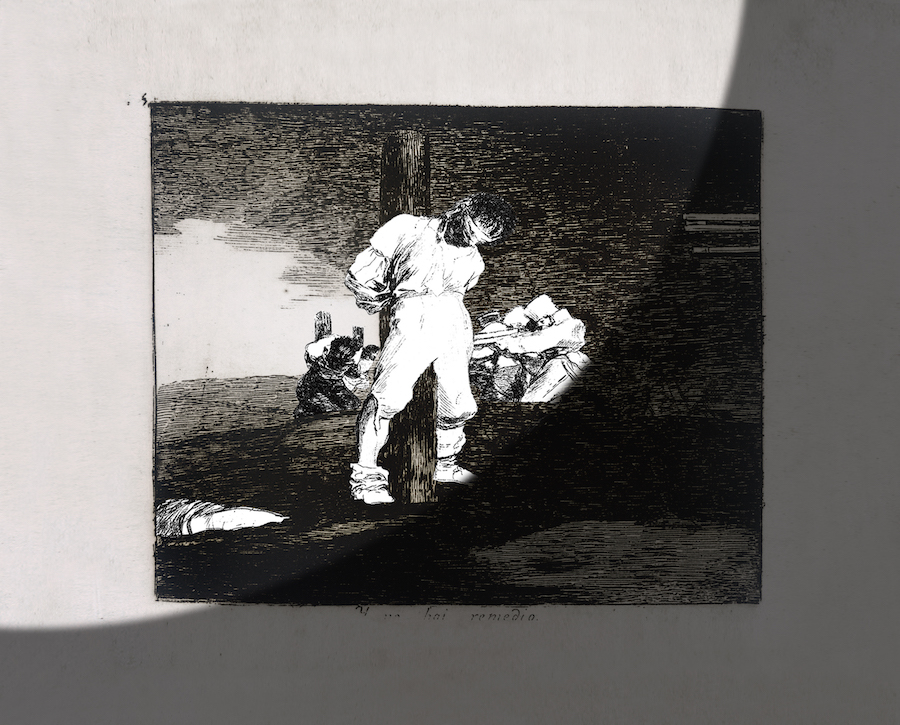
Detail: "And there's nothing to be done" from When I count, there are only you ... but when I look, there is only a shadow. Farideh Lashai. British Museum, London
This is the story of a 21st century Iranian woman and a 19th century Spanish man meeting together in the Prado Museum, Madrid. The East/West frontier and the 200 years that separate them dissolve through the use of imagery, a means of expression first used by Goya and then by Farideh Lashai so as to denounce the dramas surrounding them: fratricidal wars, the cruelty of and between men, torture. Goya initiated the road towards modernity with a new but eternal message challenging injustice and Farideh, in re-envisioning his "Disasters of War", makes that message her own. Along with the recent anniversary celebration of Picasso's "Guernica" in Madrid, the works of both Goya and Farideh would seem to join their voices to his in a communal scream. The lives of Goya y Farideh are entwined by several parallels: Goya lived through the Napoleonic invasion of Spain while Farideh was witness to events in modern Iranian history; from the arrival of Mohamed Mosaddeq, to that of Shah Reza Pahlevi, as well as the Iran - Iraq war. Both suffered voluntary exile and both sought refuge in art during illness and introspection at the end of their lives. This is, essentially, the story of an obsession ~ that of Farideh with the works of Goya.
Some of Chopin's "Nocturnes" should only ever be played senza tempo, allowing the melody, as if it were an anxious human voice unable to escape, to flow around us in waves that encircle and imbue us. Farideh Lashai's Nocturne emits from the piece it accompanies and lodges in the walls and floors of this little room in the Prado, forcing us to view Goya's "Black Paintings", the "Executions Of The 3rd Of May 1808" and "The Charge of the Mamelukes" on either side of it, in a completely different light. And it is here in this little room between them that Farideh Lashai has been invited to exhibit her "When I count, there are only you ... but when I look, there is only a shadow", an exhibition sponsored by the Friends of the Museum Foundation. The work, previously on show in the Museum of Ghant and continuing on later to the British Museum which is its current owner, will never again experience such an exceptional setting. Goya's "Black Paintings" will never leave Spain. For this reason, before leaving for Bilbao Fine Arts Museum, the Prado's director Miguel Zugaza thought it only proper for Farideh's work to be positioned here in amongst them, endowing them with a sense of the far-off and at the same time, embellishing them with a light different to that of the lantern illuminating the white shirt of the man about to be shot in "The 3rd Of May".
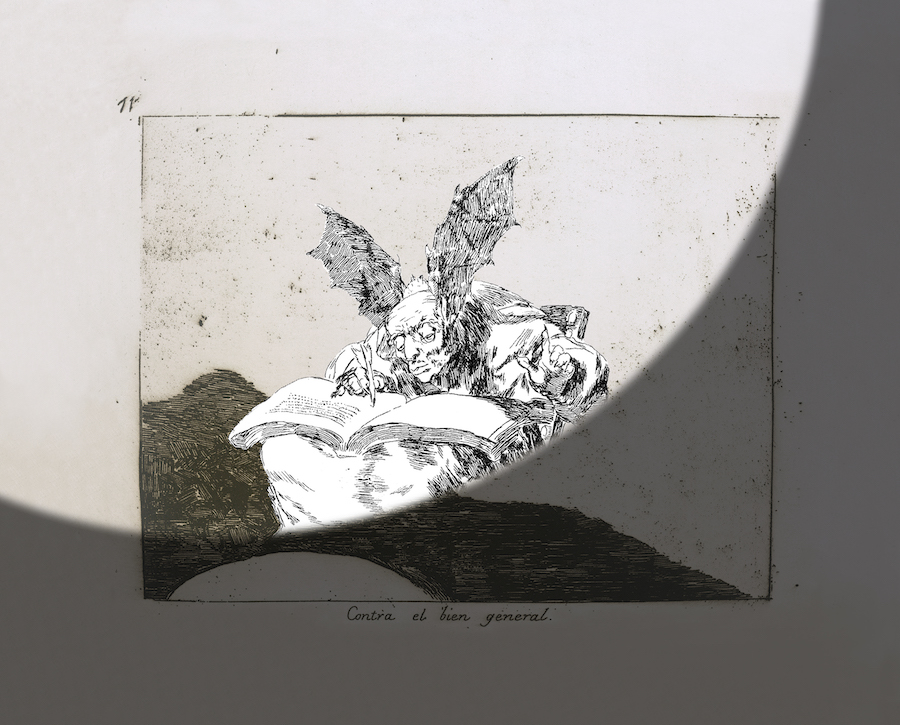
Detail: "Against the common good" from When I count, there are only you ... but when I look, there is only a shadow. Farideh Lashai. British Museum, London
"When I count ..." (2012-13), based on a T. S. Eliot poem, is the title of Farideh's latest work. Not at all surprising in that poetry is known as the bride of Persian literature, or that gardens were said to have grown on the Zagros mountains in the Iranian plateau, and lyrical poetry was a way of life for Farideh(1944-2013), one of Iran's most important contemporary artists. For this alchemist of sculpture, painting and stained glass design, writing was her backbone: "I lived in the city of Rasht until I was six. Those first few years left a strange mark on me. In the end, the place someone's born is like their mother: we're united by a primordial bond", she says in her autobiography "Shal Bamu". Whilst still a young woman, she travelled to Germany and studied at Frankfurt University where she found herself profoundly influenced by the works of Bertolt Brecht, at least six of whose books she translated into Farsi, as well as other works by Ginzburg. On her return to Tehran, she was arrested and imprisoned for three years in Qasr jail. Farideh knew no rules.
The exquisite text of the catalogue written by Ana Martínez de Aguilar, who curates the exhibition and who also translated the artist's autobiography from Farsi to Spanish, is entitled "I guard everything within myself". This phrase sums up the character and life of a nomadic woman who travelled to and from Persia from the rest of the world. In her book, written as a stream of consciousness, Farideh allows jumbled memories to flow from her childhood, surrounded by an earthly paradise of forest, sea and mountain ranges, through mystical Iranian poetry and on to political chaos. These leaps into the void mingle with her own memories, those of her mother and those of her grandmother. It's a matrilineal story in a patrilineal context that reflects personal and political life in the Iran of the 20th and early 21st centuries. All this pieced together with written words, painted words, layers of paint, and more words because as Farideh always said: "The joy that writing gave me was enough. To be able to capture a moment in words. To write meant images emerging like in a painting. In fact, I painted moments in time ... a dash of colour here followed by another there, or overlayed, in the same way that images follow one after the other from the written word. The synthesis of my work now turns out to be in the form of a collage."
This way of painting in layers came to fruition 7 years before her death when, already diagnosed with cancer, she began to use video-installations. This was her way of both avoiding the smell of oil paint whilst, at the same time, formulating a more complete message: to a still canvas she added movement, music and narration.
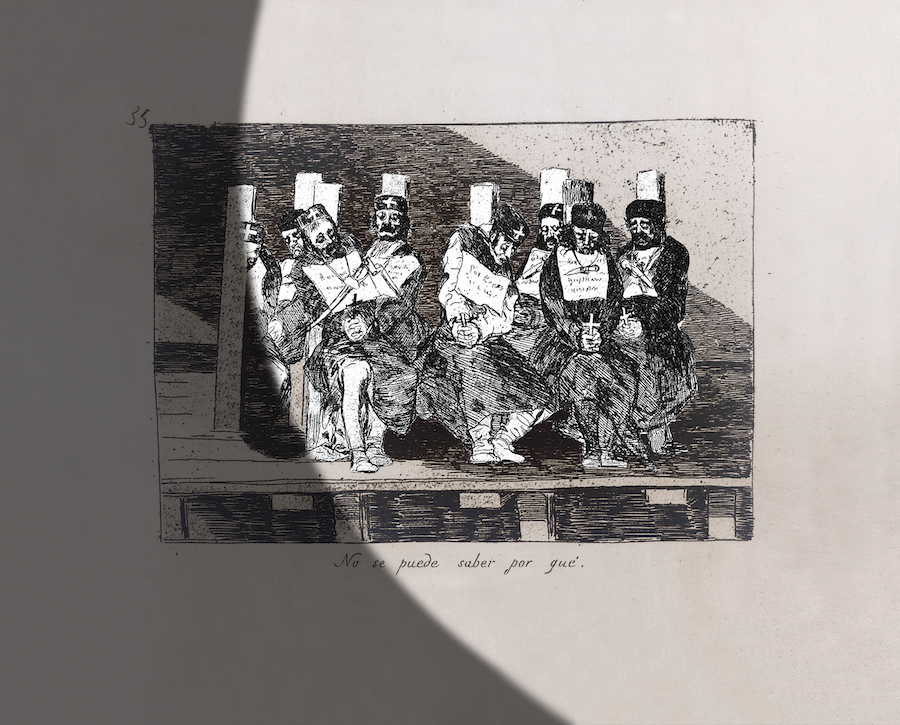
Detail: "Impossible to know why" from When I count, there are only you ... but when I look, there is only a shadow. Farideh Lashai. British Museum, London
For "When I count ...", Farideh takes Goya's "Disasters of War" series and manipulates it by removing every character from every scene. Men, women and children disappear, leaving only empty scenery, as in "A heap of broken images, where the sun beats" from Eliot's "The Waste Land". The original prints are no longer recognisable. They are now something else, something transformed into what could be the nondescript background to any other scene of desolation. There only remain ruins, scorched trees and lonely hills. It was Bertolt Brecht who first remarked on Goya's empty landscapes and this resonated strongly with Farideh who returned to the theme when, in the very last days of her life, she sees photographs and film of the outbreak of the Arab Spring.
Farideh scanned the figures and transferred them to digital film. The new photogravures are arranged in a rectangular pattern comprising 80 of the 82 prints from Goya's original series. The empty landscapes come to life as a moving beam of light, much like a theatre spotlight, is projected over each "Disaster", adding in the figures and animating them for a couple of seconds. The effect is magical and the influence, once again, of Brecht is palpable, as is that of Chinese and Iranian theatre, albeit from further away.
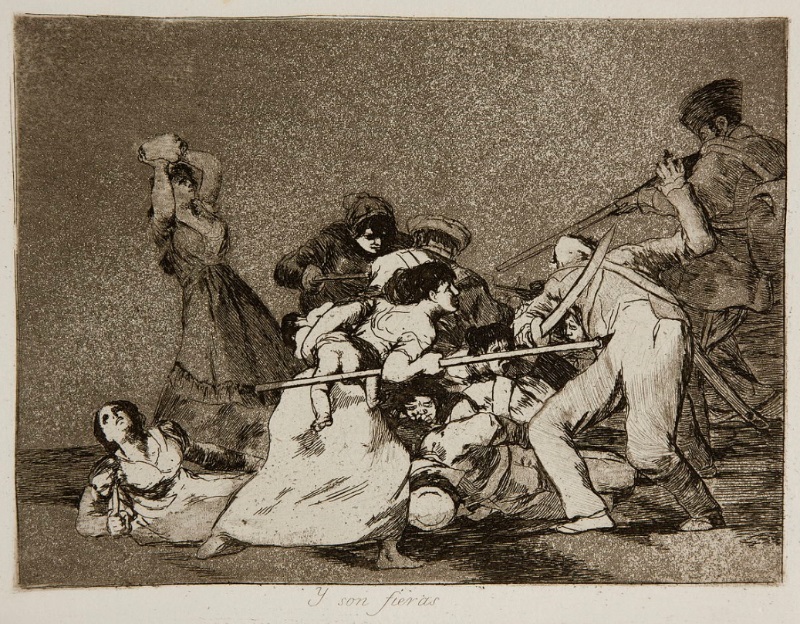
Detail: "And they too are fierce" from When I count, there are only you ... but when I look, there is only a shadow. Farideh Lashai. British Museum, London
Farideh's entire oeuvre is loaded with subtlety, including time lapses: the mere 2 seconds that each print is illuminated is long enough to have impact while still allowing us to blink and put the horror we are seeing into some kind of context. The beam illuminates the cruelty which then disappears into shadow while the spotlight continues on to the next scene. This less frenetic rhythm, this more intermittent repetition comes, perhaps, from Persia where the appearance and disappearance of history's most terrible moments forms part of its culture. In western cultures, our forced saturation in violent images by the media has anaesthetised our ability to take in the true horror of a car bomb in Kabul or the effect of shrapnel on a child's body, as happened in Manchester. Thanks to this distinct rhythm, Farideh re-educates our vision, makes us ask ourselves questions and insists on leaving us to ourselves, even when the light goes out: "Video meant a bridge to literature and offered me enormous scope for expressing myself. It brings something unexpected to my painting and creates a sensation of surprise. Also, when the video stops, the nature of the painting will have acquired a different meaning." And this sensation is so real that, after contemplating her work for a while, we walk to Goya's "Black Paintings" where the late Farideh's intentions are fulfilled. In "Fight To The Death With Clubs", our eyes don't just remain transfixed by the fight between two men, rather they travel down to the mud covering them up to their knees and the sky, ominous with clouds.
Among all her early travels, Farideh Lashai felt the need to be in Spain and pay a visit to the Royal Chapel of St Anthony of La Florida. This is what she wrote of it: "Goya's tomb was simple, seemly and sad - a rectangular slab of stone and a bunch of flowers beneath the dome of frescoes he himself painted. One of Franco's soldiers stood guard at the iron railings and I thought about who was resting in peace under that cold stone, about the man who was part of a revolution."
{youtube}PE8gx3om_SY|900|600{/youtube}
(Translated from the Spanish by Shauna Devlin)
Farideh Lashai
When I count, there are only you ... but when I look, there is only shadow
A work invited to the Prado Museum
Paseo del Prado
Curator: Ana Martínez de Aguilar
Until 10 September 2017
Farideh Lashai
Between the motion And the act Falls the Shadow
Edward Tyler Nahem Fine Art
Calle Sánchez Bustillo 7, Madrid
Curator: Paloma Martín Llopis
23 June - 13 July 2017
- Broken Images: Goya and Farideh Lashai - - Alejandra de Argos -




